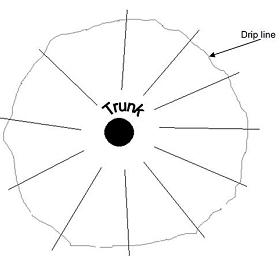Radial Trenching
Radial trenching is a fairly common procedure used on trees to achieve any or all of the following goals:
- Aeration of the soil
- Partial decompaction of the soil
- Fertilization of the soil
- Inoculation of the Root Zone
The procedure is quite variable, and various different products are employed to achieve the desired effects.
Overall Procedure
Radial trenching involves drilling or digging narrow trenches beneath the canopy arranged like spokes of a wheel around the trunk. Typically, you would start a trench near or beyond the dripline and trench toward the trunk, stopping no closer than 6 inches for each inch of trunk diameter. For example, for a 20-inch-diameter tree you should stop the trench 10 feet away from the trunk. Be careful to avoid cutting roots greater than one inch in diameter. With newly planted trees, you can dig the trenches right up to the root ball if roots have not yet grown outward.
Dimensions of Trenches
Researchers have not yet determined the ideal trench width. Experiments have used widths from 4 to 24 inches and depths of 12 to 18 inches. To avoid damaging a lot of roots, we recommend the narrower trenches 4-inches wide and no more than 6 to 8 inches deep.
Drilling Equipment
Trenches are dug using any of various tools including an air spade or a standard ditch witch. Again, be careful to avoid cutting roots greater than one inch in diameter.
Pattern of Trenching
Trenches are dug radially as shown in Diagram 1. The ends of the primary trenches nearest the trunk should be spaced apart about 1.5 to 2 feet. For large areas, secondary trenches can be cut halfway between these, extending from the dripline inward to about one-half the length of the primary trenches.
Filling Trenches
Trenches are filled with a variety of different mixtures, depending on the intended effect. For simple aeration, trenches are often filled with pea gravel. For fertility, trenches can be mixed with fertilizer diluted with soil. For inoculation with mycorrhizal fungi, trench fill can be mixed with the appropriate inoculant. For recently planted trees, inoculate only the first 1-foot of trench nearest the trunk, where roots will enter soon. In such cases, a double rate of mycorrhizal inoculant is suggested.
Roots Radial Trenching Product
ROOTS M-Roots is an ideal radial trenching amendment used to provide organic material and 3-3-3 fertility, all while inoculating with mycorrhizal fungi to improve water and nutrient absorption. The product is mixed with the soil in each trench. Mix ROOTS M-Roots with soil or fill at a rate of 3-oz per square foot of trench. For a 4-inch wide trench, 3-oz will treat 3 linear feet of trench. Visit www.lebanonturf.com for specific product information.
Radial Trenching Diagram

Radial trenching involves drilling or digging narrow trenches beneath the canopy arranged like spokes of a wheel around the trunk.
Radial trenching involves drilling or digging narrow trenches beneath the canopy arranged like spokes of a wheel around the trunk. Typically, you would start a trench near or beyond the dripline and trench toward the trunk, stopping no closer than 6 inches for each inch of trunk diameter. For example, for a 20-inch-diameter tree you should stop the trench 10 feet away from the trunk. Be careful to avoid cutting roots greater than one inch in diameter. With recently planted trees, you can dig the trenches right up to the root ball if roots have not yet grown outward. This allows a channel of loosened soil for new roots to follow.
Trenches typically extend about 4 inches in width and about 6 to 10 inches deep. For a medium to large size tree, trenches of 4-inches wide by 8-inches deep are typical.
For Recently Planted Trees:
- Dig trenches right up to the edge of the root ball.
- Inoculate only the first 1 foot of trench nearest the trunk with Roots M-Roots at a double rate of 6-oz of M-Roots per square foot of trench. So if your trench is 4-inches wide, use 2-oz of M-Roots to treat 1 foot of this trench length.
- If deeper trenches are dug for other reasons, apply inoculants to only the upper 6 or 8-inches.